| BRICK HOUSE FARM
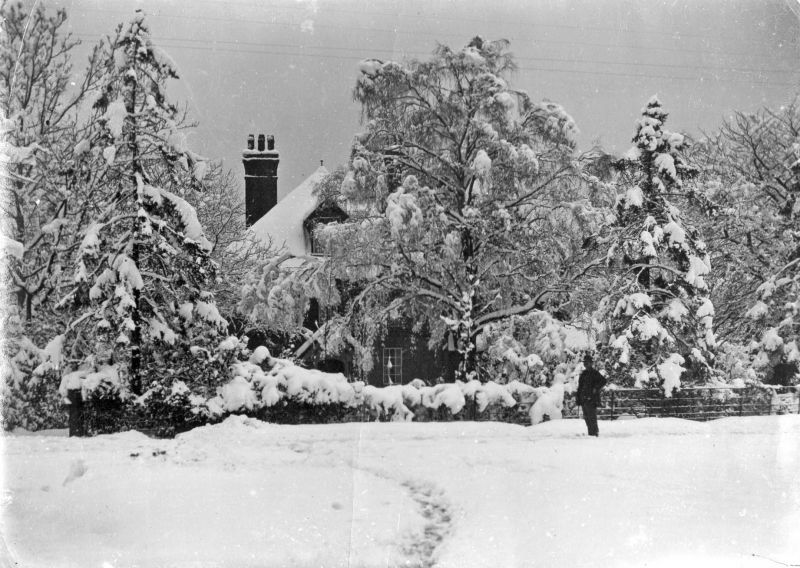
Brick House Farm, this photograph was probably taken in the harsh winter of 1947
Built circa 1780 originally timber framed, the red brick cladding is of 1885,
subsequent to earthquake damage. Two storeys, with cellar and attics. Red
plain tile pyramid roof. Three window range late C18 double hung vertical sliding
sashes with glazing bars. Centre first floor window has semi-circular head.
Gabled dormers to each side of roof. Late C19 porch. Late C19 single storey
service range on west side in red brick with red plain tile roof, with crested
ridge tiles. Internally there is extensive late C18 detailing including staircase
with wreathed handrail, reeded balusters and carved spandrels, carved door linings,
and fire surrounds. Early C19 cast iron fire surrounds on first floor. Hallway
has plain vaulted "gothic" plaster ceiling, and there are 2 ogee doors with
pineapple finials. Original semi-circular fanlight, re-used above west door.
historicengland.org.uk/listing/the-list
The above detailed entry for Brick House Farm for its Grade II listing in 1982 provided a good starting place for looking into the
history of this farmhouse and those who have lived in it. Notable families who have lived and worked there include the Bullocks, the Overalls, the Fairheads, the Butts and currently the Davidsons.
The current owners believe the internal house was built earlier than the listing would indicate, possibly in the reign of Queen Anne (1690 to 1710).
Unfortunately, no deeds seem to have survived and discovering who owned the farm and who lived there has relied on censuses, electoral rolls and trade directories plus family members' memories.
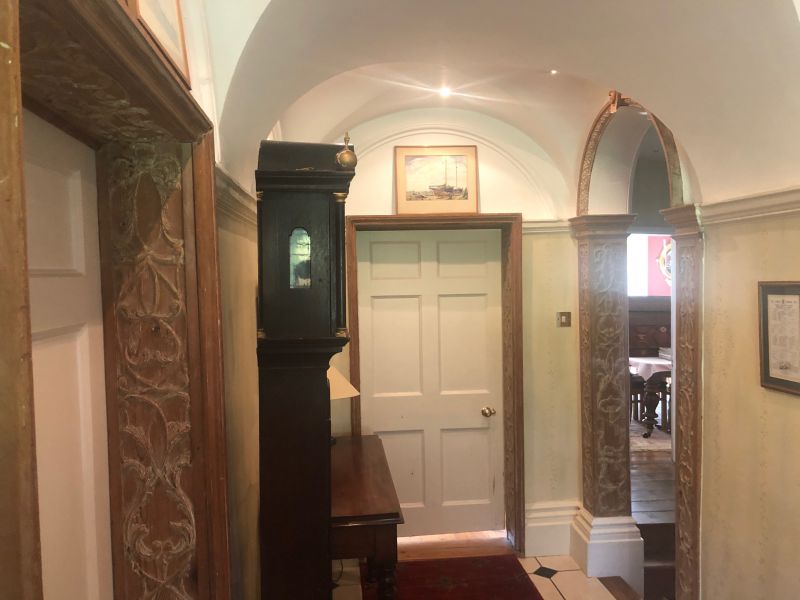
Brick House Farm showing the 18th century carved door frames
A very small part of Brick House's land belonged to the Rectory Manor in Peldon since for centuries it had been glebe land and it was therefore partly copyhold (a kind of leasehold).
In 1086 the Domesday book records that Peldon Church had 30 acres of land, the proceeds of which, would have been used to give the village's rector a living.
The ancient rectory is believed to have been where The Plough Inn now stands and, until recent times, land along the north side of Lower Road was church land while the fields between the upper (Church Road) and Lower Road are rented out by the church. It seems the land extended southwards across the road.
From unpublished research by former Peldon resident, Pat Moore, she found
The glebe land belonging to the Rector of Peldon consisted mostly of three fields lying between what is now Brickhouse Farm and Newpots Farm. The living could not have been a rich one!
The name 'Brick House' appears as early as 1847 in the Peldon Electoral Roll. The current owners believe it was at some point in its past known as Red House Farm, which is confirmed in the 1838-1840 tithe awards, and it may also have been known as Eley's after a family who lived there.
The earliest reference I have found to an occupant of Brick House Farm, is in the parish records mentioning William Mortimer of Brick House who served as one of Peldon's Surveyors (in charge of the roads) in 1790, 1791 and 1794 to 1797. It is likely it is the William Mortimer, farmer, who died on 19th September 1799 in Danbury, (although his will gives his place of residence as Peldon). He left property to his wife, Sarah, including Honey Hall and Vines, (the former likely to be Rolls or Malting Farm and the latter Malting Cottage), as long as Sarah remained unmarried. Upon her remarriage or decease, their son William, apparently an only child, was to inherit. William the Elder's will also refers to a lease he held on another property which although not named could be Brick House Farm.
All my Right and Interest of and in the Term of Years
that shall be to come and unexpired at the time of my Decease
Of and in the Lease of the Farm which I now
hold and Occupy under Samuel Deeks
[E.R.O The Will of William Mortimer D/ABW 114/2/77]
In 1801, widowed, Sarah Mortimer, still at Brick House, serves as a Parish Overseer, a post that involved making provision for the poor of the village. What happened to her subsequently is not known.
It is worth noting that it was common practice for owners to not only have tenants but the tenants to have subtenants. I suspect the owner of Brick House was John Eley (whom we are about to meet), the tenant Samuel Deeks and his subtenant William Mortimer.
In the Poll book of 1763 there is a John Eley listed as living in Feering and owning property in Peldon and again, in 1774. The 1774 Poll book lists his Peldon property as freehold.
John Eley was living at Prested Hall, Feering, at the time of his death in 1800. His will confirms that he still had property in Peldon which he wished to be passed on to his wife, Mary née Roberts, for her natural life and then to his son John after her death. Although the house is not named in Eley's will, it is described as being occupied by Samuel Bullock, who, as we shall see, was the next owner of Brick House Farm. Incidentally, both Bullock and Eley, appear in the 'Homage' (a jury consisting of the great and the good) for Peldon Rectory Manor Court meetings in the late 1700s.
We know Samuel Bullock owned the house subsequently and, incidentally, had family connections with Samuel Deeks who is listed as Mortimer's landlord in the will quoted above. Deeks' wife Sarah was Bullock's late wife's niece and was living with Bullock at Brick House Farm when he died.
Also I give and bequeath to my niece, Sarah Deeks who lives with me the sum of £20 of lawful money for a suit of mourning and a
ring at the discretion of my Executors
[The Will of Samuel Bullock ERO D/ABW 120/3/15] [MARG_195 ]
Is it not likely that Samuel Bullock bought the farm he was renting following John Eley's death? Only six years later, after Samuel Bullock's own death in 1814, a property that is very likely to be Brickhouse Farm was sold at an auction of his estate.
Particulars and Conditions of Sale of Several Valuable estates at Peldon and Wigborough, the late property of Mr Samuel Bullock deceased which will be sold by auction by James Thorn at the White Hart Inn, Colchester on Saturday the 1st day of July 1815 at 4 o'clock in the afternoon in eight lots
I believe Lot 1 (out of 8 lots) was what is now known as Brick House Farm.
Lot 1 A capital freehold brick messuage with two stables Chaisehouse and granary over the same, good Gardens and other convenient outbuildings the late residence of Mr Bullock situate in Peldon with 11a: 3r: 29p [acres rods and perches] or thereabouts of good arable pasture land thereto adjoining and a Cottage thereon in Three Roods of the Lot are Copyhold of the Manor of Peldon Rectory Subject to a Fine arbitrary on every admission, and the Land Tax is Redeemed.
The Cottage mentioned was Brick House Cottage, demolished some years ago for modern housing.

Brick House Cottage nestling by the granary garden wall belonging to the farmhouse. Now replaced by modern executive houses, Vineyards and Magnolia Cottage.
The Chaisehouse and granary are still there, a Grade II listed building.
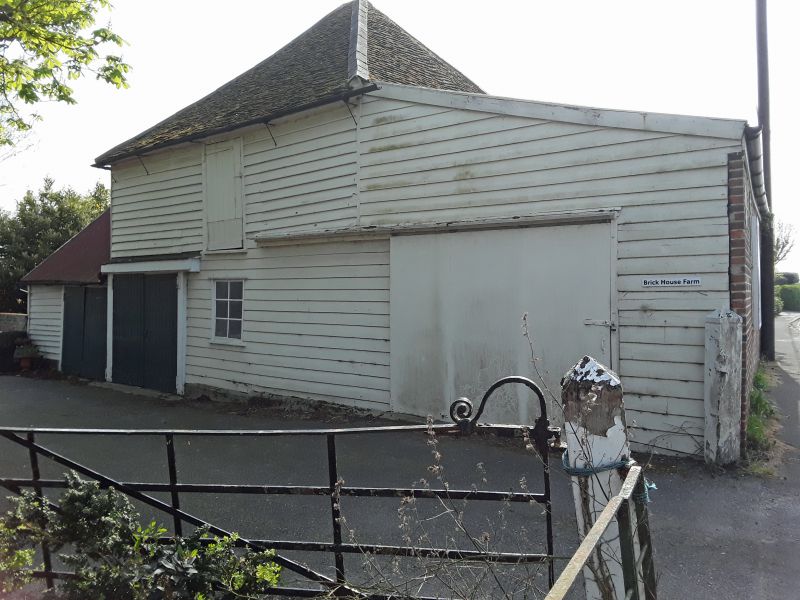
Granary to west of
Brickhouse Farmhouse
C18 granary, timber framed, brick and weatherboarded. Red plain tile pyramid
roof, with weathervane. Later lean-to extension on north with grey slate roof.
historicengland.org.uk/listing/the-list
The current owners confirm that the Bullocks lived in Brick House - there is graffiti in a window pane by Elizabeth Bullock, who etched her name and that of a friend, Jane Game, dated 1785.

Etching in an upstairs window of Brick House Farm
Jane Game
August 9
1785
Elizabeth Bullock
We know Samuel had a daughter called Elizabeth (1764 - 1811). She married surgeon, William Jones, and they were to live in Tolleshunt D'Arcy with their two children. Elizabeth and William are buried in a box tomb next door to her family's vault in Peldon Churchyard. Did she etch her name in the window pane? She would have been about 21. As for Jane Game, we know that Thomas Game and his family were living at Games Farm in 1785.
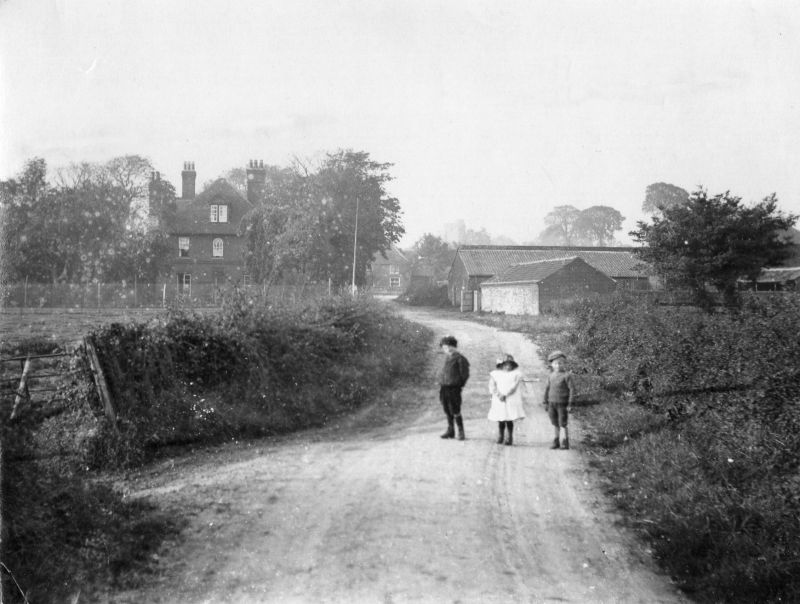
A view of the back of Brick House Farm, The Old House on Lower Road can be seen at the end of the lane
The Gibson and Dakins families
Peldon's tithe awards were surveyed and published between 1838 and 1840 and give a snapshot of owners, occupiers, field names and acreages.
Brick House Farm is listed as being owned by Wyatt George Gibson with the occupier Edward Smythies Dakins.
After the Napoleonic Wars there was a decline in farm incomes and either by default of Mortgage or desire to sell, about one third of
Peldon came under the ownership of Wyatt George Gibson, Banker and Brewer of Saffron Walden. This is shown on the 1838 Tithe Map and
his holdings, consisting of five farms, mostly South of the Mersea to Maldon road were all occupied (managed) by
Edward S Dakins. ...... Three generations of the Gibson family held land in Peldon, and in 1920 Mary Wyatt Gibson, spinster, is shown
in the rolls of the Manor of the Rectory of Peldon, to be accepted as tenant to some Glebe land, so she must have still been an active
landowner in Peldon. She was the daughter of George Stacey Gibson and granddaughter of Wyatt George Gibson.
Pat Moore, unpublished history of Sampton Wick, Peldon
Wyatt George Gibson owned huge areas of land, houses, and marsh in Peldon and after him, his son, George Stacey Gibson. Was he the successful bidder at the auction in 1815?
From the tithe awards, the farms Wyatt George Gibson owned that can be identified are Brick House Farm, White House (now Sampton Wick), Newpots, and Sampsons along with many other houses and parcels of land.
The Gibsons were a wealthy Quaker family who lived in Saffron Walden, owned a brewery, bank and several pubs, and were influential in the town in the nineteenth century. They sank a public well to provide safe drinking water, opened schools and contributed to public buildings. In 1863 they donated a handsome drinking fountain which still takes pride of place in the market. They were involved in funding the purpose-built Saffron Walden museum built in 1835 and the Bridge End garden created by Francis Gibson Gibson circa 1840.
As absentee landowners in Peldon they made donations to the expansion of the village school in 1872 and towards repairing Peldon's Village Pump in 1884, presumably after the earthquake.
Wyatt George Gibson was a traditionalist who dressed and spoke as an old-fashioned Quaker. He was active in local affairs in Saffron Walden and served on the Town Council as Councillor and Alderman from 1835 to his death in 1862. In his will he bequeathed a substantial sum of money to build a hospital in Saffron Walden.
Wyatt Gibson's son, George Stacey Gibson, referred to by biographer, Jeremy Collingwood, as 'Mr. Saffron Walden', was a very successful business man and served the town as mayor.
From an early life Gibson was interested in chemistry and botany. He became a noted naturalist and botanist and published a book
Flora Of Essex G S Gibson. He had correspondence with Matthew Arnold and another Essex naturalist, John Ray.
In 1863, after his father's death, George Stacey Gibson was admitted to the land held by Peldon's Rectory Manor.
In April 1883, George Stacey Gibson died and after making provision for his wife and daughter, he left to his cousin, Edmund Birch Gibson, farms in Peldon occupied by William Golden Fairhead and Henry Woodward whom we will meet later.
George Stacey was probably Saffron Walden's greatest Victorian benefactor but also its richest citizen in his life-time. When he died on 5th April, 1883 he left an estate valued at probate as £342,456 18s 0d. In that year his estate was the fourth largest granted probate.
Gibson's wife, Elizabeth, died in 1890. Their only child, Mary, continued to live in Saffron Walden until her death in 1934, and, as we have seen, was admitted to some glebe land in Peldon in 1920.
In 1873 the Local Government Board presented a major survey of landownership to Parliament, a 'Second Doomsday Book'. In this, George Stacey is credited with 1,980 acres in Essex worth £4,429. Also listed are the landholdings of his father W. G. Gibson and Mrs Gibson amounting to 570 acres and 238 acres respectively (however with W.G. dying in 1862 this was a little out-of-date). Overall then, George Stacey probably held 2,788 acres with an estimated income from rental of £5,470.
As for Gibson's tenant listed in the Peldon tithe awards, Edward Smythies Dakins, he was the son of the Reverend John Dakins and his
wife, Elizabeth. When John Dakins died in 1839 aged 68 he had been rector of St James Church, East Hill, in Colchester for 40 years and
he and his wife, Elizabeth, are buried in the Lady Chapel in St. James. In the St. James Church Guidebook (now no longer available)
Edward Dakins, their son, we are told, owned houses with gardens in Peldon.
Mary Hopkirk, in her history of Layer de la Haye, tells us Reverend John Dakins was accustomed to supplying officiating ministers in his absence from his ministry and this extended to several villages south of Colchester, including Peldon, which had an absentee incumbent for twenty four years.
Peldon's incumbent, Jehosphat Mountain was instituted to Peldon in 1782 but in 1793 emigrated to Canada while still retaining the incumbency of Peldon. It was not until his death in 1817 that Peldon was able to institute a new rector and until then Dakins' role in supplying ministers was essential.
Curates were one of Dakins' specialities. At this time he was also providing them for Abberton, Peldon, Berechurch, Virley, Salcot and
Wigborough from his own staff at St. James, and when there were not enough to go round he officiated himself.
The Story of Layer de la Haye by Mary Hopkirk .
Dakins clearly had a close relationship with St Mary's, Peldon, judging by the number of times his signature appears in Peldon's parish registers and witnessing wills.
The Reverend Dakins never lived in Peldon but it seems his son, Edward Smythies Dakins did, albeit briefly.
It is Edmund Dakins who is listed as the 'occupier' of several of Wyatt Gibson's Peldon farms, Brick House, White House and Newpots. The tithe awards reveal he was also the owner of five houses in the village. He and his wife Harriet, who married in 1836, were to have a daughter, Francesca, in 1839, who died at only 15 months. Her baptism and death are both listed in Peldon's parish registers as is the baptism of her sister, Francesca Maria, in 1842. The Dakins did not have any more children and by the 1851 census they were living in Kent where they were to stay. In the censuses, Dakins is described first as a GP, then as a surgeon and on his probate he is described as a surgeon and apothecary.
Henry Woodward and Stephen Waller
As we have seen, one of the Gibson family's tenants was Henry Woodward and in Peldon's 1851 census he is listed as the farmer of 470 acres employing 20 men. He is living with his wife, Lucy, and three children. His brother-in-law, Stephen Waller, is living with the family and also listed as farming 470 acres and employing 20 men!
Both Henry and his brother-in-law had clearly been farming in Peldon before then because they appear in the 1844 Kelly's trade directory as farmers, no farm specified.
From 1847 to 1854 Stephen Waller is listed in the Peldon Electoral Roll as occupier of Brick House while from 1852 George Wyatt Gibson is listed as owner, also of Newpots and White House. The listing in 1847 of 'Brick House' is the first mention of the name I have found so far.
In the Essex Herald of 21st September 1852 there is an advert for an auction on 29th September of live and dead stock at Brick House
Farm by direction of the Proprietors, Messrs Woodward and Waller whose tenancy terminates at Michaelmas.
By the 1861 census the whole household are at Heath farm in Stanway. From the place of birth of Henry's children and the above information it would seem his family actually lived in Peldon roughly between 1844 and 1852.
The family clearly continued to farm in Peldon for in the Kelly's trade directory of 1874, Arthur Waller Woodward, Henry's son, is listed as the farmer of Sampsons. From George Stacey Gibson's will in 1883 it would seem that Henry Woodward still had an interest in an unnamed Peldon farm.
Stephen Overall
Stephen Overall (born in 1806 in Mundon) was living at Brick House Farm in both the 1861 and 1871 censuses. He is listed in the Peldon Electoral Rolls as being occupier of Brick House from 1854 while the owner is given as George Wyatt Gibson. It is clear Overall took over the tenancy from the Woodwards. and is listed as the occupier up to the 1869 roll. (Essex Records Office does not seem to have further Electoral Rolls).
In 1871 he had 551 acres and employed 25 men, 11 boys and 4 women.
Stephen Overall also appears listed as a farmer in Peldon in trade directories in 1862, 1863 (White's) 1867, 1871 (Post Office) and 1874 (Kelly's).
Throughout the 1860s the vestry minutes for Peldon show that Overall was elected each year as the Guardian of the Poor, the village representative to the Stanway Union workhouse, responsible for looking after the old, infirm and those unable to work.
Stephen Overall was to die on 28th December 1877 and the farm was auctioned by direction of his executors. His nephew was his sole
heir. The auction was on 27th September 1878 as published in Chelmsford Chronicle. At the same time Newports and White House
were to be auctioned - presumably all part of Stephen Overall's farming business.

This photograph (courtesy of Sandra and David Conway) is probably Stephen Overall's wife, Elizabeth Overall née Grove formerly Rand. She was Mary Overall Smith's grandma; it reads
Mother's grandma
Brick House
Peldon
The Fairheads
The Fairheads were the next family to live and farm at Brick House and stayed for some decades, up to just before WW2.
It has to be remembered that the Gibsons were still the landowners, and incoming farmers like Stephen Overall and the Fairheads would be leasing the farm.
In Peldon's 1881 census William Golden Fairhead, who is 24 and born in Birch, is farming 566 acres employing 18 men, 6 boys and four women. His wife is Eliza Rachel Fairhead also born in Birch and they have a little boy Arthur William aged 7 months, born in Peldon, who sadly died at the age of 1.
In 1883 George Stacey Gibson died and it is likely Brick House was bequeathed to his cousin, Edmund Birch Gibson, presumably this made little difference to their leaseholders, the Fairheads.
It was reported in The Essex Farmers Fairhead Family Fellowship by A E Fairhead, (a history of his family, which included the branch at Brick House Farm, Peldon), that the farm was sufficiently damaged in the 1884 earthquake to necessitate them moving out temporarily while it was repaired. It has been suggested that Mr Fairhead, being in charge of distributing the Lord Mayor's emergency Mansion House fund to local residents, used the opportunity to improve his property as well as repair it! The current owners tell me that a brick shell was built around the existing house, the original windows were re-used and a third storey added.
William Golden Fairhead's son, Stanley, was born the month after the earthquake at Abberton Cottage, now in Layer de la Haye but once
part of Peldon. The Abberton Reservoir now separates the two halves of this lane, Lodge Lane. It's not known how long the family stayed
there. According to the listing above from the British Listed Buildings Register, the red brick cladding on Brick House Farm dates to
1885 from when the repairs were made and the plans for the changes made to the farm are held by Essex Records Office.
[E.R.O. D/F 8/37/1 - 5]
By 1891 the Fairheads had four sons, Francis William aged 8, Stanley aged 6, Percy Golden aged 4 and Clifford aged 8 months. They also had two daughters, Mabel Constance aged 5 and Margaret Ethel aged 2. All were born in Peldon. By 1901 they had three more children, Bessie aged 9, Charles Edward aged 7 and Herbert aged 6.

A postcard from the Osborne series of the front of Brick House Farm

A postcard of the rear of Brick House (courtesy of Ron Green). Are these members of the Fairhead family in the garden?
By 1911 the Fairheads have had another daughter Kathleen Eva aged 8. Percy Golden at 24 is a farmer, Charles and Herbert are assisting on the farm and Clifford is a chemist's assistant. According to this census William Golden and Elizabeth had twelve children, 9 living and 3 deceased.
Head of the family, William Golden Fairhead (1856 - 1918), was churchwarden of St Mary's, Peldon, from 1883 to 1892 and also acted as the Correspondent for Peldon School, checking attendances on registers and managing finances and the fabric of the building. He, like his predecessor, Stephen Overall, was elected as Guardian of the Poor for Peldon and attended meetings at Stanway Union workhouse.
According to the family history,
William Golden served on the Essex County Council to become an Alderman and was vice chairman of the Lexden and Winstree Rural District Council and in both capacities served on many committees, notably the Essex Education Committee and the Lexden and Winstree War Agricultural Committee. [www.fairhead.org.uk]

[Photo courtesy of Helen Jones]
The Fairheads ran an agricultural contracting business and in this photograph above, Arthur Polley and sons from Ardleigh are thought to be harvesting around 1910. The living wagon has W.G. Fairhead Peldon on the side and the steam engines are for ploughing.
The Fairheads, at different times, also had leases on many of the farms in Peldon including Harvey's Farm, Haxells and Traceys, Kemps and Home Farms.
William Golden Fairhead's death at the age of 62 on 16th October 1918 was reported in the newspaper of Friday 25th October 1918. His probate records both sons, Percy Golden and Stanley, farmers, as executors.
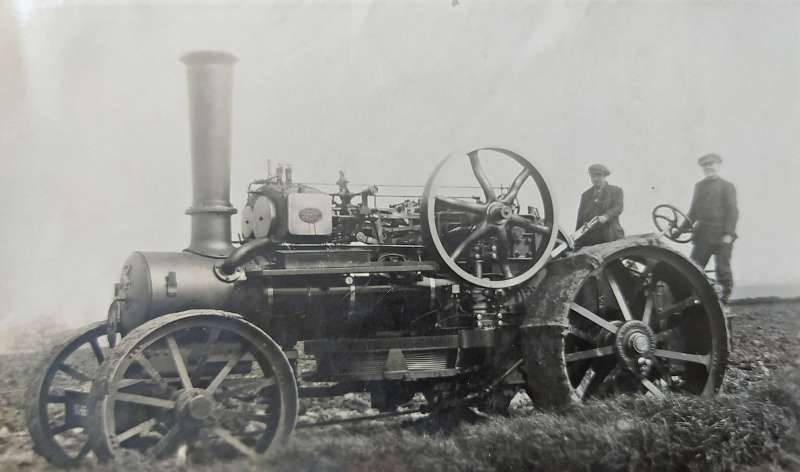
[Photo courtesy of Helen Jones]
The photograph above of an Aveling Porter Ploughing Engine with Cecil Baldwin from Peldon on the right and Charles Polley on the left
probably dates to the early 1920s. Both men worked for the Fairheads for several years.
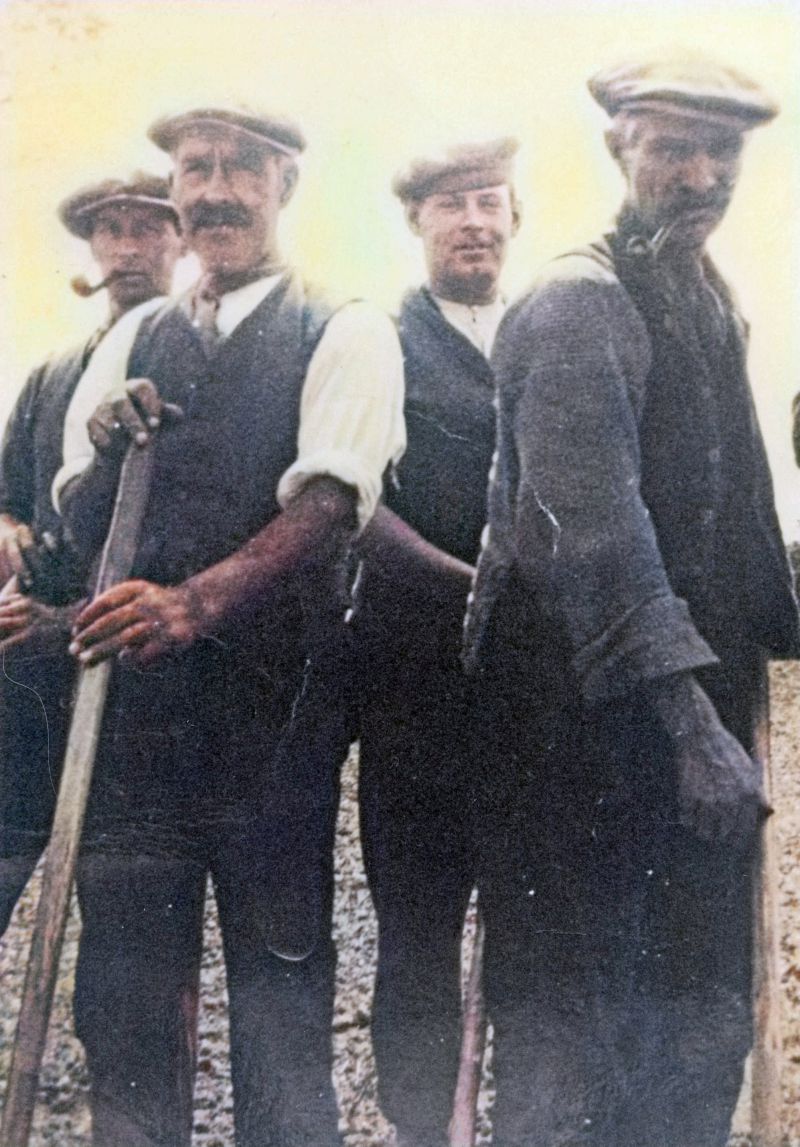
Four labourers who worked for the Fairhead family. Left to right Charles Polley, William Polley, possibly Frederick Baldwin and Arthur
Howard [photo courtesy of Helen Jones]
Cecil Baldwin's nephew Tony tells us that Cecil worked for the Fairheads from a young age, driving steam engines. They would travel widely - Harwich for example - with a live-in van for the week, and cycles on board to enable them to get home at the weekend. As a boy, Cecil would have to be first up in the morning, to raise steam; in later life, according to his granddaughter, he reckoned he'd ploughed every field from here to Colchester and out towards Weeley. Cecil's granddaughter remembers him telling her they ate steaks every night to fuel the hard work and in later life all the 'old boys' used to go to all the traction engine fairs to reminisce.

Cecil Baldwin at the back and possibly his older brother Frederick seated on the right [Photo from Helen Jones]
One of William Golden's sons, Stanley Fairhead, was to farm at The Rows, Layer de La Haye where later the first Essex Wildlife Visitors Centre for Abberton Reservoir would be built on his land.
From The Essex Farmers Fairhead Family Fellowship we learn son Percy Golden Fairhead married Winifred Bunting and they had a
daughter. Percy, lived and farmed at his father's farms in Peldon but these activities were curtailed and the farming stock came
under the Auctioneers hammer and Percy took up work elsewhere.
In the 1914 Kelly's Trade Directory Percy was also managing Home Farm, Peldon, and in the 1929 directory he was managing both Home and Kemps Farm while the executors of W G Fairhead (which included Percy) were still running Brick House Farm.
William Golden and his wife, Elizabeth Rachel, plus Percy their son, are listed as voters in the 1918 Electoral Roll and by 1929's roll Elizabeth Rachel, Margaret, Clifford, and Charles Fairhead were all listed, also Kate Emmeline Balls who I suspect was a servant.
Through bankruptcy, Percy was forced to auction the farm before the war and he went to Cuckoo Farm where he became farm bailiff of
Essex County Mental Hospital Ltd; known as Severalls. In Kelly's he was listed as farm bailiff in 1937. In the 1939 register he
was Manager on Farm also an ARP warden. He died in 1945.
John and Margaret Butt
John and Margaret Butt were the next farmers at Brick House Farm. Born in Devon in 1884 to a farming family, John Butt moved to Essex with his parents in 1899 to farm St. Andrews Farm, Latchingdon. The local newspaper obituary for John picks up his story
.. farming was not very remunerative in those days and so John Butt borrowed his fare and sailed to Australia on March 10, 1910.
He stayed in Australia sugar-cane cutting for nearly three years.
.. By the time he came home in 1913 he had saved enough money to buy a small farm of his own in Latchingdon.

John Butt in Australia. John is standing third from left with folded arms and a machete.
John married Margaret in 1914, and they had one son, Henry George Butt, in 1916.

John and Margaret Butt standing behind the bride and groom in 1923. The wedding was that of John's younger sister, Eleanor
(Bessie) Butt.
Moving between several farms, including Althorne Hall Farm, John arrived at Brick House Farm in 1935 upon the departure of the Fairheads.
While in Peldon, John and Margaret immersed themselves in village life and with the onset of war were to play their part in the village's preparations for possible invasion. The 1939 register also reveals that they took in two evacuees, young brothers, John and Stephen Breeze from West Ham. Margaret was to be a founder member of Peldon WI formed in 1942!
In January 1942, the Parish Invasion Committee was officially set up and Margaret was the representative to the Rural District Council while John was the vice-chair. At that meeting, large houses were earmarked to be used for casualties and it was agreed Brick House Farm was to take twelve if needed, it was also to be the Distribution Centre for milk and potatoes. At the end of December 1943 John replaced the Chairman of the Invasion Committee who had moved out of the village. Recording this appointment, the parish minutes note John's address as Lodge Farm not Brick House.
Sadly, John Butt had become the victims of the push to maximise food cultivation during the war and was one of several farmers locally to be evicted by the Essex War Agricultural Committee.
In 1943, Stanley Ellis, a dairy farmer at Pete Tye Farm, Peldon, also received an eviction notice and it was his appeal to Peldon's
rector, The Reverend J.R. Wilson, that prompted a national campaign championed by renowned author, journalist and countryman, James
Wentworth Day. [See Farmers' evictions in WW2, and the Peldon Protest ]
Moved by Stanley Ellis's predicament, Reverend Wilson wrote to Wentworth Day and a meeting was held in Peldon Rectory, as described in Day's book, 'Harvest Adventure'.
Wentworth Day tells us about 25 - 30 people attended the meeting and lists most of the farmers by name including Mr Butt of Barn Hall
and his brother of Peldon Marshes who farmed 500 acres of marsh.
Mr Butt of Barn Hall was dairy farmer, William Harold Butt, and his brother of Peldon Marshes was our John Butt of Brick House Farm.
They told their story. How farmer after farmer had been given notice to quit without any good reason at all and without any possibility
of appeal to an independent tribunal. How orders to break up old grassland had been served and how, when the necessary machinery was
appealed for, it was not forthcoming. How overbearing Committee men and officials... had told these bewildered farmers and their wives that the Committee possessed all but the power of life and death over them ...
An enormous campaign followed involving public meetings, the setting up of a new Countrymen's Association and huge press coverage but
the end result for those already threatened with eviction was the loss of their farms.
It would appear, like the Ellises, the Butts had been required to move out of their farm during 1943.
As good fortune would have it I have been in touch with two of the Butts' relatives who were able to provide photos and biographical information.
My grandmother, Eleanor Bessie Butt was John and William's young sister. Therefore, John and William were my mum's uncles. Eleanor had married John Crow, he bought a farm in Runwell, Essex and was supported by John Butt. John Crow died at a young age when my mum was about 7 years old, after which time, John Butt became her father figure. My mum in her young days regularly stayed at Brick House Farm (with the etched glass in the bedroom) and Lodge Farm, Peldon. She also stayed at Uncle William's farm, Barn Hall, Tolleshunt Knights, where she spent the night in the room with the timber beam allegedly thrown up onto the hill by the devil.
All in all the two brothers either leased or owned a fair number of farms between Peldon and Maldon, both sides of the Blackwater Estuary.
The Butt family had farms in Devon and Cornwall into the 1960s. The family still own Bohuns Hall [Tollesbury]. John Butt and his wife
Margaret are buried together in Althorne churchyard, reason being, John's favourite farm that he owned was Althorne Hall. John Butt
acquired his wealth by working on the Australian sugar plantations during 1910-1913. John Hawes by email
Dudley Butt's grandfather was John's brother, William Butt of Barn Hall, Tolleshunt Knights.
I was born in Tollesbury where Uncle John farmed at Bohuns Hall and his grandson and great grandsons are still there. That would have
been after Brick House Farm. He later went on to be a Chairman of Tollesbury council and maybe on Maldon District as well. My
grandfather farmed at Barn Hall, Near Salcot and the whole of our part of the family moved to the Isle of Man to farm in about 1950.
I managed a year at Birch School before we left. Dudley Butt by email
The family confirms that John and Margaret Butt remained in Peldon following their eviction from Brick House Farm and the timing of
their removal to Lodge Farm ties in with the previous owners, the Goldings, leaving the farm during 1943; the next owners of Lodge
Farm, the Jacobs, seem not to have moved in until 1947. The Butt family still has a milk gallonage certificate stamped J. Butt Esq;
Lodge Farm, Peldon and their house-guest at Brick House Farm in the 1939 register, Francis H Bass, a farmer and family friend from
Althorne, is also recorded as being in Lodge Farm in 1945 [Essex County Standard Neighbourhood News 20.7.1945].
Despite their changed family and work circumstance the Butts continued to be very involved with Peldon's parish life, John became chair of the parish council and he was key in organising war-time fundraisers and 'Welcome Home' and Victory parties.
After John's eviction, Brick House Farm was taken over by a prominent member of the Essex War Agricultural Committee, Lexden farmer,
Alderman Alexander Craig, who used to host local War Ag meetings in the farmhouse.
The advert for letting the farm from Michaelmas 1944 was placed in the newspaper by the War Ag Committee.
Essex War Agricultural
Executive Committee
invite Offers for the following
Farms to Let
from MICHAELMAS, 1944
There followed a list of 22 farms throughout Essex including four other local ones including Brickhouse Farm.
Bower Hall, West Mersea, (164 Acres plus 94 Saltings) 258 acres
Hill and Fields Farm, Layer-de-la-Haye 250 Acres
Brickhouse Farm, Peldon, 511 Acres
Whitehouse Farm, Layer Breton, 127 Acres
Lower and Middle Farms, Tolleshunt D'Arcy, 166 Acres
Further Particulars, Conditions of Letting, and Form of Offer (which must be returned so as to reach me not later than 25th July), may be obtained from the Land Agent, Essex Institute of Agriculture, Writtle, Chelmsford.
R.N. Sadler
Executive Officer
6th July, 1944
John Butt moved to Bohuns Farm, Tollesbury in 1947 where he ended his days in 1975, aged 90, having continued farming right up to the age of 85.
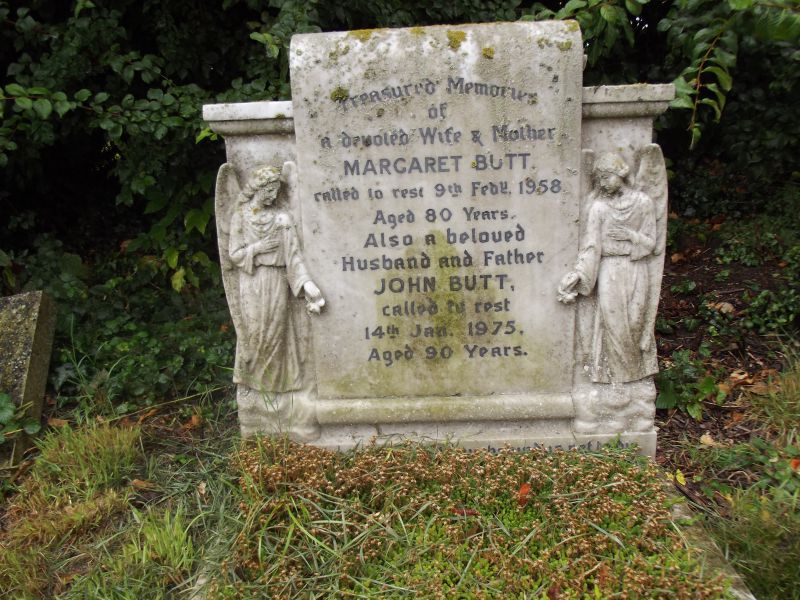
The grave of John and Margaret Butt in Althorne Churchyard
The Davidsons
The current owner's grandfather, Robert, and father, Andrew, originally came down in 1925 from Scotland to Essex to farm and at
Michaelmas 1946 moved into the 500 acre Brick House Farm.
The family tells me their holdings included Newpots and Sampsons, the three farms having been farmed as one since the nineteenth
century.
Andrew Davidson and Molly, daughter of Alexander Craig of the War Ag, were to marry in 1949 and their son, Robert, assisted his father until taking over the business, a third generation to do so.
Brick House Farm became well known for continuous wheat production, winning a reserve world wheat championship and as a demonstration farm for the Ministry of Agriculture, Fisheries and Food for over 30 years; it is now growing its 66th year of continuous wheat.
Although mainly arable farmers, for twenty years, Robert and Liz Davidson kept a large flock of sheep and annually lambed over 1,000 ewes. Liz did the bulk of the shepherding and Robert concentrated on the arable side of the business. Visiting the lambing pens became an annual treat for local residents but the foot and mouth outbreak of 2001 put an end to sheep farming on such a scale and the number of animals on the farm has dwindled to two faithful Labradors!
Now the Davidsons' nephew, James, with his wife Zena, run the farm assisted by their team of skilled staff; crops now grown include winter wheat, oil seed rape, barley, peas, grass and most recently rye and maize for grain and bio-gas fuel.
Elaine Barker
Peldon History Project
Thanks to
Tony Baldwin
Dudley Butt
Robert and Liz Davidson
Ron Green
John Hawes
Helen Jones
Pat Moore
Marianne Smith
Pat Wyncoll
Sources
Jeremy Collingwood: Mr Saffron Walden: The Life and Times of George Stacey Gibson
Fairhead family history series by A.E. Fairhead
James Wentworth Day: Harvest Adventure

The staircase in Brick House Farm showing period features
|